Topless Hedonism: We Compare M6, XKR-S, SL63 AMG, and 911 Carrera S Convertibles
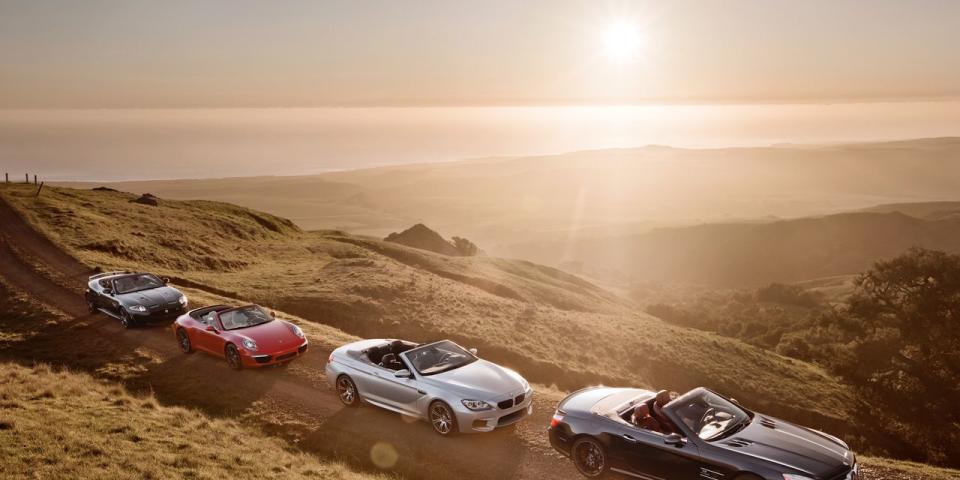
From the May 2013 Issue of Car and Driver
TESTED
About halfway between Los Angeles and San Francisco, somewhere near the Piedras Blancas lighthouse where the sea otters bob and the elephant seals tussle in the slimy kelp just off the shoreline, the Santa Lucia Mountains take a step back from the water’s edge, leaving a rolling, doughy apron of greens and browns. On January days when the gray doesn’t hang low and the squalls don’t roll in on the crest of a sniping wind, the fog can settle with damp permanence and bleach everything the color of statuary.
In 1865, a man named George Hearst came and spent some of his mighty takings from the Comstock Lode on a cattle ranch here. It must have been a sunny day, because when the sun is out in San Simeon, heaven has no equal. Hearst found his refuge on these hillsides, and his son and heir, William Randolph, would eventually build a towering concrete château big enough to be labeled a castle.
It is a fact of American life that the victors get the spoils. Ranches and castles are two, and a vehicle to access them quickly and in sublime comfort is another. At one time the Hearst property here encompassed 250,000 acres, so, likewise, we were not tame in our appetites. Our four convertibles live in the very upper reaches of luxury, just where it scrapes the bottom of the exotic realm.
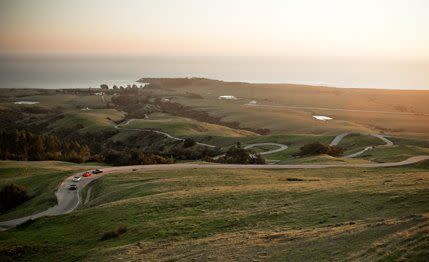
None costs less than 130 large with options, though the BMW M6 comes closest as our price leader, even with its optional, special-order $5000 “Frozen Silver” matte paint finish. The Bimmer has a number of -ests on its curriculum vitae. It is the longest, widest, tallest, and heaviest in the group. Its twin-turbo 4.4-liter is the smallest of three V-8s here, but makes the most horsepower in the test, at 560 (the Benz gets the torque medal, at 664 pound-feet).
The dash-S marks this XKR as Jaguar’s hottest number, with a 550-hp supercharged V-8 that blurs the scenery in this aluminum-bodied, British Racing Green (but, of course) sprinter. At $138,875, the XKR-S is complete with no options, though, as with the M6, the premium for the convertible version is $6300 over a coupe.
Optioned to the hilt with, among other things, a $9000 performance package that adds carbon-fiber bits and 27 horsepower, this $171,225 Mercedes-Benz SL63 AMG lands 10 grand shy of a Bentley Continental GT V-8 coupe. The two-seat SL with its 5.5-liter twin-turbo V-8 is our only dedicated roadster; no coupe is available. But it is also the only one with a retractable hardtop that turns it into a decent facsimile of a coupe.
Last in both alphabetical and dimensional order is the Porsche. Befitting a Stuttgart stallion, the 911 Carrera S cabriolet is the smallest and lightest car here, and it also suffers the least horsepower. Yet it is not the least expensive, at $136,430. You can get into one for $108,950, but the Premium package ($4445, with heated power seats, bixenon headlamps, and other froth), the Burmester audio package ($5010), Porsche Dynamic Chassis Control ($3160), or any of the many other options might be temptations too many. We asked for a PDK to match our other automatic contenders, but all Porsche could provide was a seven-speed stick with just 350 miles on the odo.
European art was William Randolph Hearst’s passion, and we’ve brought some—albeit using a definition of the word he would find rather loose—to his former doorstep to see which one best befits a baron in his castle.
Like Hearst Castle itself, the M6 strikes us as a noble project that got entirely out of hand. It’s just so enormous. And heavy. Yes, we know it’s a 5-series sedan underneath, and it is handsome. But how can the M6 weigh 368 pounds more than the Benz, which has an entire forced-air furnace system in its seats and a team of robots aboard to fold its metal top like the Hôtel du Louvre’s housemaids working over a bed?
Well, the M6 has semi-usable back seats, for one. And it spares no inches to make you comfortable up front. The beam is wide, leaving room for generously tailored front buckets and a center console as broad as a deli counter. The nav-info screen stands prominent, like a roadside billboard, and is easy to operate. As you repose in comfort, you survey your vast estate of leather ($3500 extra for the full dash-and-doors package), carbon-fiber trim, and wind-wrought sheetmetal, and you feel mighty.
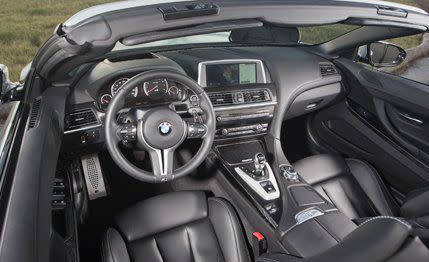
Especially when you poke the 4.4-liter twin-compressor V-8. A launch-control mode makes the M6 the second-quickest to 60 mph and through the quarter-mile after the Benz, and the big BMW is always ready to surge forward on a fat if somewhat lumpy rush of torque from its industrious engine. If your transportation needs involve crossing time zones, you could do a lot worse.
However, you can also do better. Even with all its many driver-adjustable settings for steering effort, throttle response, and suspension stiffness, it’s impossible to make the M6 fully at home on winding roads. The steering is duller than the others, and the body wallows and leans more as the mass pushes the suspension around. An overriding sense of isolation meant the clearest feedback we got came from our drivers, complaining that they felt less confident driving hard into corners, unsure if the grip would hold.
Certain details seem haphazard. Where the top’s great spinnaker of canvas meets the body behind the cockpit, it sits on a thick, black-plastic coaster that clutters the bodyline when the top is down. All of the cars except the Jag have wind blockers. In the M6, the squat, rectangular rear window can be motored up separately to serve as such, giving the open M6 an especially quiet cabin at freeway speeds. But it looks bucktoothed and totally uncool. Nothing on a car this expensive should be uncool.
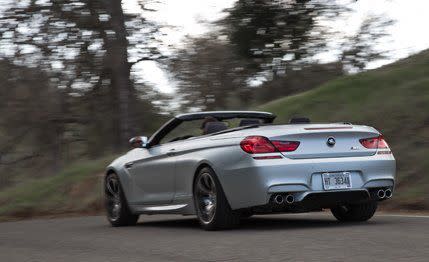
There’s an artificiality to the M6, from its soft-then-hard brake pedal to the way the engine sounds more like interstellar gas eruptions than internal combustion. We know BMW plays engine sounds through the audio system’s speakers, and the M6 is the only car here in which the engine note gets quieter and more distant with the top down. Hmph!
The M6 is not horrible, but it’s not really an M, either. It’s too girthy, too soft, and too ersatz. If only it were as good at generating emotion as it is at generating test numbers. BMW needs a separate badge for these ultrafast luxury barges, the M5 and M6, to separate them from the M3. Until then, we’ll just rate it a “U” for uninspiring.
In contrast to the anodyne BMW, the Jag is pure animal rage. Start the engine, and it sounds like it’ll leap through the hood and eviscerate you. You can’t turn your back on this car or it will take you out—you and a telephone pole. W.R. Hearst had a thing for exotic beasts; he would have had a place in his hilltop zoo for this one.
We’ve written about the XKR-S before. It’s got a bit too much horsepower for the polite society that Jaguars normally inhabit. It’s obscenely, wonderfully loud, and the chassis does not suffer fools. It eats them. If you dare to switch off the stability control, you’d better have quick reflexes, because this thing likes to run sideways.
We recently had one at a track, and it proved too much of a handful. With the red mist dialed down, we said, it would make a fine road car, and sure enough, it does. The steering still feels remote, but the grip and path control are superb, and the suspension feels more natural and fluid with its single setting than the BMW’s does on any one of its three.
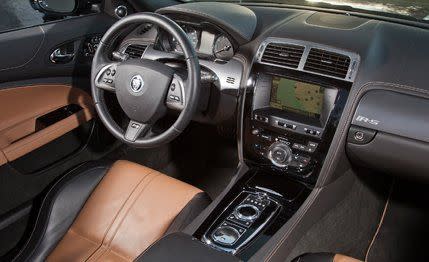
Top down and windows up, the Jag goes quiet in cruise mode, the ride stiffness a respectable compromise even if it can’t be electronically adjusted. Jaguar lovingly renders the cabin in leather, this one in a black-and-caramel combo evocative of a Christmas box from Callard & Bowser. The “R-S” logo is elegantly embossed in metal-like trim on a dashboard trimmed with lovely French stitching.
Thickly cushioned down the center, the seats feel a little high and unsupportive, with a ridge that cuts some drivers across the lower back in an odd way. At least you can pinch in the torso bolsters with the door-mounted controls.
Lacking electronic launch control, the XKR-S can’t lay down its power as effectively as the big Germans, so it suffers some in the acceleration times. But it never seems slow, as the gas pedal feels connected to the 5.0-liter V-8 via piano wire that provides instant response. And it’s the only car in the test that holds its driver-selectable competition mode—which adjusts the throttle, transmission, and stability-control settings—after you switch the car off. The others default back to their Sunday church modes.
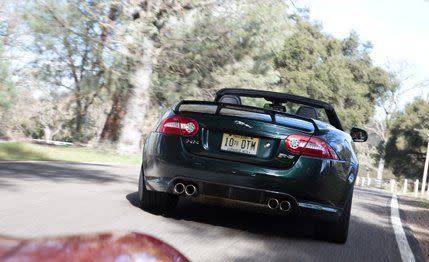
So what’s it doing down here in third? In some ways the Jag feels as eight-years-ago as a Motorola flip phone. The cockpit touch-screen is clunky and slow to boot, and the nav display is all thick lines and bare color fields lacking in detail. It’s embarrassingly old school in the iPad era. So is the simple display screen between the gauges that offers little additional car info, and the general lack of amenities, such as the all-windows-down button found in all the others. Even staid, stalwart Mercedes has finally cured its numb steering.
Though its overtly thrilling personality is a winner, the Jag feels outdated, a fact we’d make less stink about if its hefty price wasn’t so very au courant.
It’s no secret that Benzes have been growing on us. The world’s oldest car company has found a dynamic sweet spot that displaces even BMW. The new SL is a perfect example. It does just about everything exceedingly well, being the best fusion of luxury and sporting qualities in this test.
So it’s a shame that the styling has few friends here. We’re not sure why Mercedes’ designers believed that the SL, basically unchanged around the middle from before, needed tons of visual heft to its front and rear. But there it is, baggy in the butt and with excess overhang. If you like it and can accept the price, well, don’t mind us then, because the Benz is otherwise the star with the star.
It’s often chilly along this rocky coast, but the Benz keeps you wind-protected and cozy, with a heater system in the seats (part of the $4300 Premium package) that directs warm air on your neck. The robo-roof is a fascinating gas-station sideshow, and a second quickest to lower and raise after the Porsche. Once it’s up and you’re on your way, it insulates the cabin from noise better than any top here. The trade-off is reduced trunk space when the top is down.
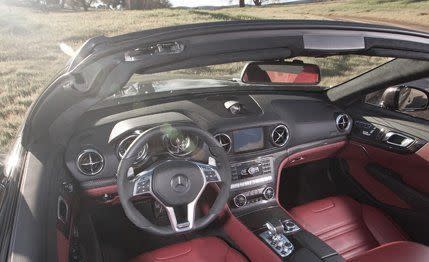
Two soothing, red-leather thrones are set in a cabin that has been stitched and tucked and fitted with burnished metal and glossy carbon fiber to epicurean exhaustion. Options notwithstanding, it looks and feels worthy of its inflated price tag, which is saying something. Even better, the SL’s lavish opulence is troweled onto a platform that can move. With alert steering at hand, powerful brakes underfoot, and the fortissimo V-8 barking in the ears, the driver has nothing but smiles in store on a back road. The second-lightest car in the test manages its 4128 pounds well, and the chassis sets pleasingly in corners with the road firmly clutched in its claws.
Benz has sorted the twin-turbo thing better than BMW, whose engine builds pressure slowly, then suddenly bolts for the redline. In part because it’s more than a liter larger than the M6’s, the SL’s 5.5-liter V-8 has the throttle linearity of the Jag and Porsche, a byproduct of its fabulous torque. Even so, the AMG returned the same 14-mpg fuel economy as the BMW and Jag. Not that we’re particularly proud of 14 mpg, but at least there’s no penalty for all that extra power.
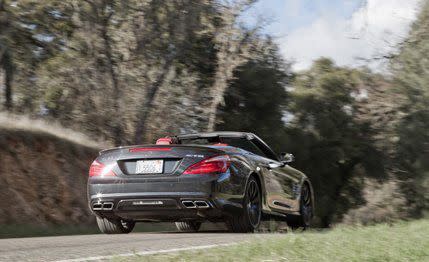
The only hitch was a stop-start system that malfunctioned once and left the SL stalled at a light. We had to switch off and reboot the car before it would restart.
Like others, the SL defaults to its comfort mode on startup, and in that mode the gas pedal goes a little limp, especially coming out of corners when the transmission is reluctant to downshift. AMG endowed this car with a ton of sporting ability; it shouldn’t make drivers switch back to sport mode every time they fire up the engine.
At this price, you’re still $37,380 short of an SLS AMG GT roadster, and in many ways the SL63 is a better car. It’s more comfortable and more usable daily. And if you can do without black forged wheels ($2200) or electrochromic roof glass that darkens at the touch of a button ($2500), or any of the other $19,820 in options on our maxed-out tester, so much the better.

We don’t know if Hearst had Packards or Cadillacs or Hispano-Suizas to run his guests up the hill from his private airstrip (no doubt somebody will write in with the answer), but the Porsche is the best car in this day and age for the job. It is immediate, it is thrilling, it is loud in a brassy, mechanical way that sends shivers through your adrenal system, and it is a joy.
W.R.H. was surrounded by family and friends, and a bit broad in the beam himself later in life, so he surely would have scoffed at the smaller Carrera with its narrow buckets and vestigial rear seats.
Though the 911 has ballooned dimensionally in recent years, it’s still intimate inside, especially compared with the other four-seaters here. A new, sloping center tunnel evocative of the Panamera is studded with buttons and divides the cockpit into distinct hemispheres.
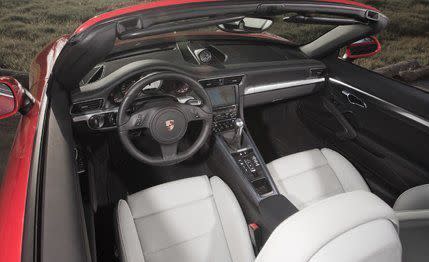
Everything about the Carrera is quick and nimble. Even the top needs only 13 seconds to do its thing. The steering is prompt and tight, filtering out the unwanted chatter of a rough road while allowing through the pulls and pulses of tires hard at work. The sense of connectedness to the chassis is strong and it lures you to heroic speeds. Note the wide margin by which the 911 established skidpad and slalom supremacy, at 1.03 g’s and 47.3 mph respectively.
Just 400 horsepower from the flat-six out back makes the Carrera S the caboose on the drag strip, but the 911 would have surely been quicker equipped with the dual-clutch auto and launch control, and with a few more miles on its clock. As it is, the Porsche delivered the best fuel economy.

Few convertibles have good outward visibility with the roof up. The SL is one exception; the 911 isn’t. Top up or down, the 911 also is noisier, with a wind ruffle around its glass, the persistent moan of its big tires, and the burr of its engine as ever-present companions on your long drives. The shorter wheelbase also supplies a choppier ride, even with the suspension settings turned down.
There are definitely trade-offs if you, as we do, lean to the sportiest end of our group of sport-luxury convertibles. However, even if the Porsche lacks the flashy carbon-fiber wings and gaping forged wheels of our other cars, no vehicle here is as much fun. And that’s really what cutting a perfectly good roof off is all about.

Final ResultsVehicleMax Pts. AvailablePorsche 911 Carrera S CabrioletMercedes-Benz SL63 AMGJaguar XKR-S ConvertibleBMW M6 ConvertibleDriver Comfort108989Ergonomics1091078Rear-seat Space*51025Cargo Space*51544Features/Amenities*1041059Fit and Finish1087108Interior Styling109886Exterior Styling109786Rebates/Extras*50001As-tested Price*2019131920Subtotal9568697176
Powertrain1/4-mile Acceleration*2016201818Flexibility*52444Fuel Economy*1010888Engine NVH109997Transmission1010878Subtotal5547494645
ChassisPerformance*2020161515Steering Feel1010876Brake Feel1010887Handling1010987Ride107989Subtotal6057504644
ExperienceFun to Drive2524222114Grand Total235196190184179

You Might Also Like

 Yahoo Autos
Yahoo Autos 